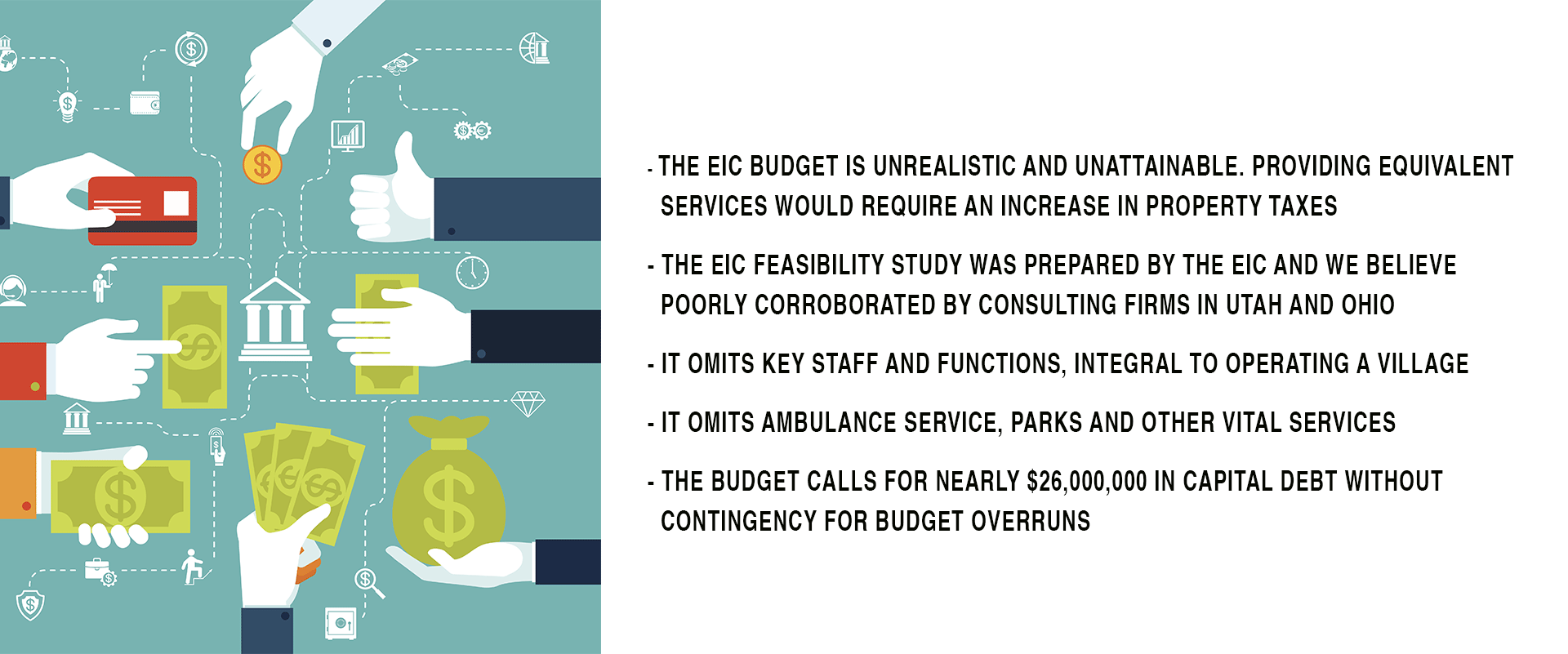The EIC presents an unattainable budget, fraught with loss or reduction of services while generating extraordinary and unnecessary long-term debt, projected at a rate without consideration of rising market, bond rates, which will remain the responsibility of Edgemont taxpayers for decades.
MUNICIPAL TAX PLANNING
Simplistically presented, annual operating budgeting by municipal entities is generally handled in the following manner:
- After a study of the previous year’s spending and a determination of all expenses required to properly provide services to the community, an expense budget is generated
- A projection of fees and other than Property Tax revenue is then determined
- The difference then becomes the amount of total Property Tax which is required
- Each individual’s Property Tax requirement is then computed utilizing the Total assessed value (TAV) of all of the properties as it relates to each property’s TAV and an owner’s share is established
- Your bill reflects your individual property’s percentage of the total assessed value of all property in the Town of Greenburgh
The EIC process appears to have been quite different.
Members of the EIC and its two, “feasibility study corroborating consulting firms,” Zions Public Finance, located in Salt Lake City, Utah and The Novak Consulting Group, located in Cincinnati, Ohio, never met with or spoke to any of the Department Supervisors or the Town Supervisor of Greenburgh. In fact, they never even reached out to set up a meeting. An accurate determination of our needs for Policing, DPW, EMS, etc., should have been calculated based upon Greenburgh’s experience, but in actuality was decided without any direct information provided by the Town of Greenburgh.
How can we rely on this report?
In addition, rather than utilizing the budget process previously described, it is clear that an operating budget was prepared by determining the Property Tax and additional Revenue available for services and then provided a level of services which that sum could purchase. This EIC model explains the reason for the jettisoning of Parks and Rec. services, generating $1,600,000 in savings, the refusal to accept the need to provide Ambulance/BLS services, generating $1,000,000 in savings, the bare bones POLICE, DPW, VILLAGE ADMINISTRATION budgets projecting inadequate staffing, equipment, and facility space. The EIC has completely ignored the between $300,000-$400,000 in Property Taxes which would need to be paid to the Town of Greenburgh should Edgemont Village build their proposed Police and Public Works facilities outside of Greenburgh. These examples are but a few of many such budget inconsistencies which render the EIC Feasibility Study and budget unattainable.
FROM WHERE WILL NEW SOURCES OF REVENUE COME??
Unlike the Town of Greenburgh, which has multiple tracts of attractive land for development, Edgemont has few to none. While Greenburgh expands its revenue base by approving plans for major developments such as Regeneron, which will expand the Town’s property tax revenue base to meet increased cost, what will Edgemont do??? As costs increase for Edgemont Village, as they inevitably will, where will those additional funds be found?? Only one place…INCREASED PROPERTY TAXES FOR EDGEMONT RESIDENTS.
LONG TERM CAPITAL DEBT
The EIC proposes generating nearly $26,000,000 of long-term capital debt while forfeiting nearly $20,000,000 of Greenburgh Town assets which Edgemont residents contributed to over decades.
Issues related to encumbering our Country and its municipalities with Long-Term Capital Debt have become a National discussion, as escalating historical deficits increase and Bond interest rates, which determine the cost of carrying such debt continue to rise.
The Edgemont Village envisioned by the EIC will carry an enormous amount of long-term Capital Debt, generated by the extraordinary capital spending which the EIC proposes, along with the required assumption of Edgemont’s yet undetermined liability portion of Greenburgh’s debt.
It is important to understand that the Town of Greenburgh has approximately $75,000,000 worth of assets, comprised of property, buildings and structures, equipment and funds. Over many decades, Edgemont’s Property Taxes have paid for a substantial portion of these capital assets. With incorporation, an Edgemont Village will lose all interest in these assets, which will accrue to unincorporated Greenburgh. Utilizing Edgemont’s 26% of Total Assessed Value of Greenburgh, we would be “throwing away” nearly $20,000,000 of assets to which we contributed over the years. The EIC makes no mention of the loss of our assets in any of their literature.
On page 58 of the EIC feasibility report, “Total Village of Edgemont Debt, Est. 2018” will be as follows:
| DPW and Police Facility and Equipment | $14,795,000 |
| Edgemont Share of Town Debt | $11,004,136 |
| Total | $25,799,136 |
The total noted above is non-inclusive of $1,605,000 for the Fire District and $1,622,750 in Tax Anticipation Notes, for “Transition Costs and Contingency,” which they believe they can payoff utilizing the operating budget and FD assets.
A NEW EDGEMONT VILLAGE WILL HAVE NO ASSETS AND VERY LITTLE IF ANY EMERGENCY FUNDS AVAILABLE. WHAT HAPPENS IN AN EMERGENCY????
The EIC utilizes an interest rate of 3%, assuming a new Edgemont Village is able to garner similar Bond Rating as Greenburgh, the Fire District and Edgemont Schools. In light of the recent increases in interest rates, the fact that EV will have no assets and significant debt, and based upon discussions with individuals involved in such Bond trading, we believe that a 3% interest rate may not be available in the future, generating additional expense to the proposed EIC budget.
The risks of long term debt and its financing are daunting and must be considered heavily.

